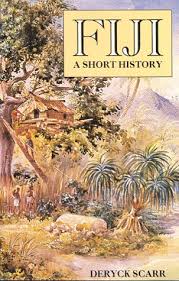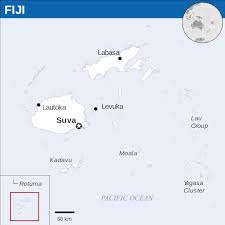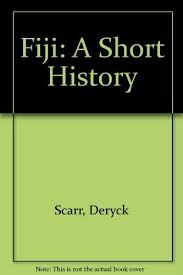A Short History of Fiji (1984) by Deryck Scarr.
GoodReads meta-data is 202 pages, rated 3.60 by 5 litizens.
Genre: Non-fiction; Species: History.
DNA: ANU.
Verdict: Read that.
Tagline: Feudalism remains.

The archipelago that comprises Fiji is a thousand nautical miles long with two hundred islands, some twenty of which are inhabited with a total population today of just under one million in Melanesia, as distinct from Polynesia (further east) and Micronesia (further north). Within these groups of ‘nesias’ (islands) there are cultural and racial similarities. Melanesians are more likely to have darker skins. ‘Poly-nesia’ means a lot of islands, while ‘Micro-nesia’ refers to small islands. Rather mixed lines of demarcation: pigment, area, and number. (‘Indonesia’ means ‘Indian islands.’)
These Pacific islanders are reputed to be descendants of daredevils who went rafting from Taiwan millennia ago.

Prior to the British arrival, Fijians divided into clans or tribes with chiefs and that has remained the primary level of social organisation. These tribes had conflicts among themselves, and occasionally pirated around nearby islands like Tonga, Noumea, Samoa, or Cook, which broadened the gene pool. Then Europeans arrived to trade first in copra (dried coconut) which releases oil if pressed. It was a fad as a luxury good in Europe.
Then came sugar cane to rival the West Indies, where blight threatened supply. That had two consequences. First, commercial interest grew, led by the CSR from Sydney, later including investor Frank Packer. Second, there came in train a demand for much cheap labour in the cane fields. This latter demand arose at a time of dislocation on the Indian subcontinent, where there was large scale internal migration to escape drought.
The result was an indentured servitude program recruiting Indians (men and women) to work in Fiji at a pittance (which was far more than they would have had in India). Estimates suggest as many as 30,000 in short order, and more later. Subsequently, the Fiji population at times has been about 50:50 between island Fijians and Indians with a smattering of others (Chinese, Kiwi, Māori, Strine, Tongan, Samoan, Brit). Per Wikipedia today the ratio is closer to 60:40.
During this colonial period, the British tried to devolve responsibility by negotiating with the Fijian chiefs about land and government. Hmm, but there were conflicts among the chiefs that hampered that. The chiefs preferred to deal with the Brits whom they regarded as equals, rather than the Indians whom they regarded as slaves in all but name. (I am going beyond the author in some of this interpretation.)
Here is what is interesting. When the Brits began withdrawing, they wanted to hand over to an elected government. The more recent example of this approach is Hong Kong. The Indians (though there were religious and caste differences among them, these were rinsed out by the Fijian waters) were keen on elections. Not the Fijians, who insisted that the chiefs nominate each other for seats in government. This mixed arrangement of half elected and half appointed was not going work very well but it lasted.
The Indians were very well organised (inspired by Gandhi) and got themselves elected with a mandate, whereas the chiefs’ purpose seemed to this cynic to be to hold onto their feudal entitlements. The differences and tensions between the two communities are deep seated.
With the proliferation of beet sugar, island cane sugar lost value, and tourism began to develop in the 1970s. Hence, our trip. We are the number one business for Fiji.

The author’s circumspection and concentration on description did put me in mind of ANU — privileged and complacent. It also made me conclude he was keeping the door open for a return visit to Fiji by not calling things as he saw them. Tricky doing that.

